Safe hiking in bear country
- by Michael Morris, Mount Revelstoke and Glacier National Parks
The Columbia Mountains provide a diverse and lush habitat for many species of wildlife, and a wonderful setting for people to enjoy a spectacular natural environment. Many people visit our national and provincial parks seeking a place to experience these wonders. Once having decided where to hike or camp, the most frequently-asked question of park staff is: “What about the bears?”
Investigating the ecology of bears is a good way to approach this question. By analyzing a bear’s habitat requirements, learning about bear foods over the changing seasons, and by studying bear behaviour, backcountry hikers, campers, and workers will be able to evaluate the relative risk of travel in bear country.
Identification
There are two species of bears in the Columbia Mountains; both are widespread throughout British Columbia. Being able to distinguish between the two is important when deciding how to contend with an encounter.

Young black bear.
Photo credit Parks Canada
Black bears are usually black, with a lighter coloured muzzle and sometimes with a white chest patch. Cinnamon coloured black bears are common in this part of British Columbia. Most adult black bears range from 70 kg to 150 kg. Their ears are large relative to the size of the head. Black bear claws are short and highly curved, which makes them ideally suited to climbing trees. Having evolved in forested environments, they typically resort to climbing trees when threatened.
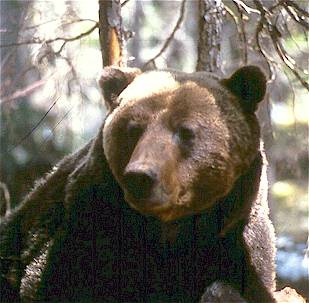
Grizzly bear.
Photo credit Parks Canada
Grizzly bears range in colour from dark brown to blonde. Their name comes from the most prevalent fur colouring which is a dark brown hair with a blond tip. On average these bears are larger than black bears, typically ranging from 100 to 250 kg. Much larger specimens are known on the Pacific coast where bears have access to salmon runs. These bears have a dished shaped head with ears that are proportionally smaller than black bears. A prominent shoulder hump of muscle can help distinguish these bears at a distance. This muscle mass assists the bear to dig with its long (up to 10 cm), relatively straight claws. Claws will be worn shorter as the summer progresses.
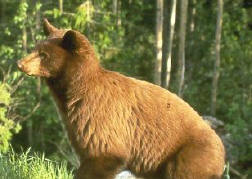
Cinnamon coloured black bear.
Photo credit Parks Canada
Reproduction
The bigger the bear, the better the chances of reproducing. In nature, passing on one’s genes in the only measure of success. For males, being bigger means access to females simply by being able to fight off other males. For females, stored fat is crucial to nursing a litter of 2 or 3 cubs for several months.
Bears mate in June but the embryo does not implant until fall, likely in response to adequate fat reserves in the female’s body. Cubs are born in February and are very small, less than 500 grams. They remain in the den for 3 months, and will weigh 4 to 8 kg by the time they leave the den in May.
Bear behaviour and bear food
Because they hibernate for half the year, bears have to eat enough in six months to last the whole year. Maximizing weight gain is the foremost concern for bears, and they are great opportunists when it comes to food.
Bears are not true hibernators; more accurately, they are dormant in winter. They maintain a near normal body temperature, unlike ground squirrels, which allow their body temperature to drop to near freezing temperatures. The advantage of a high body temperature is that bears can be aroused from their sleep if attacked in their den. However, maintaining a high body temperature costs many calories over a winter.
Adult bears in the den do not eat, defecate, or urinate for 6 months. Through a fantastic metabolic feat they can emerge from the den after a winter’s snooze, having consumed 25% of their body weight. Bears are able to metabolize waste products and some how avoid the loss of bone density during their long sleep.
Bears are attracted to prime sources of food and can be very aggressive towards possible competitors. Being able to identify bear foods is the first step in assessing bear habitat.
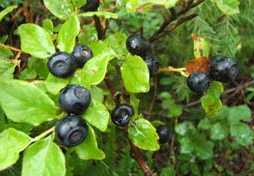
Huckleberries, a favourite late-summer food
Photo credit Jackie Morris
Black and grizzly bears eat a wide variety of plants. The following is a list of some of the more important ones in regard to availability and nutrition. These factors change with the seasons, elevation, and slope aspect.
- Roots: glacier lily, spring beauty, hedysarum
- Herbs: sedge, horsetail, cow parsnip, fireweed
- Berries: huckleberry, blueberry, mountain ash.
These plants are easy to identify. Anyone who travels in bear country should learn to identify these plants in their various phases of growth.
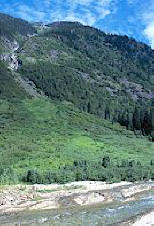
Avalanche path
Photo credit Michael Morris
South facing avalanche paths are particularly important in spring. These are productive sites for bear food because the absence of trees allows more sunlight to reach the ground. The soil in lower portion of a slide path has been built up by many years of climax avalanches that bring down nutrients from higher slopes and there is usually ample moisture. This combination of factors produces a bountiful supply of plants that bears can eat. Like us, they prefer the fresh and tender shoots of new growth which are also more nutritious. This can be maximised by following new growth emerging from the retreating snow.
Dominant male bears take the best feeding sites. Females and cubs use habitat of secondary quality to avoid confrontations with larger males who are aggressive toward anything that is competing for food. An exception to this is productive berry patches which can have concentrations of male bears in late summer and fall. In the Columbia Mountains, the best huckleberry and blueberry patches occur about 25 years after a forest fire.
Do bears use the area?
The presence of a bear can be assumed from the evidence of their activities. Interpreting the age of any of the signs of bear activity is key to assessing the significance of the sign.

Examining bear scat.
Photo credit Michael Morris
Examining fresh bear scat with a stick can reveal the type of food currently being eaten. It is not possible to determine which species produced the stool. When bears eat green vegetation the stool is dark green. The longer it has been exposed to air, the blacker it will become. By using a stick to poke the stool apart, one can determine an approximate time of the bear’s having passed that spot. Stools darken faster during warm weather. Generally speaking, it takes a few hours for the outside of the stool to darken and a few days for it to darken right through. When trying to age a scat, consider the recent weather.
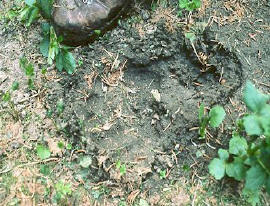
Grizzly track.
Photo credit Lynn Hardstaff
Tracks can assist in determining species. Black bears have more of an arch in the pattern of the toes and the claw marks are close to the toes. Grizzly claw marks are farther in front of the toes. A grizzly’s claw length diminishes with summer because of digging. The size of the track is not a reliable indicator of the species as there are small and large bears of both kinds. Tracks in snow will become larger as the snow melts.
The most frequent sign of bear activity is trampled vegetation in or between feeding areas. Look for these trampled vegetation trails in natural travel corridors and sites rich in succulent green vegetation.
In some areas, claw marks scar aspen trees. These become black with age and remain on the tree as a permanent scar. Black bears will feed on the seed heads of aspen during early spring. Look up when you are hiking in this type of forest.
Bears communicate their presence to each other by leaving their scent on convenient trees beside travel corridors – which sometimes are also human trails. Look for prominent trees that protrude into the trail. Typically a bear will brush past it. Less frequently, it will stand to use it as a back-scratcher. This action can leave behind a few hairs caught in rough bark or in pitch. Silvertip fur reveals the presence of a grizzly. Note that hair roots can be light coloured, too.
Bears will tear bark off subalpine fir trees and, to a lesser extent, spruce trees and rake their front teeth along the cambium layer for a sticky treat. Typically, the resulting bark damage is pointed at the top end. These scars do not heal but weather to grey wood.
Both species of bears will scratch around and turn over rocks and logs looking for insects. Only grizzly bears will dig for bulbs to such an extent that some sites appeared to have been tilled. Typically these are subalpine meadows rich in avalanche lilies. Check the dampness of the earth to gauge the freshness of the diggings. Again, the recent weather will have to be considered. Check to see the freshness of the vegetation under a clod of earth. If the flowers have yet to wilt, the digging is very fresh!
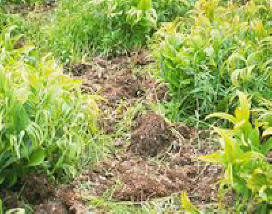
A grizzly has been digging for roots and bulbs.
Photo credit David Pitt-Brooke
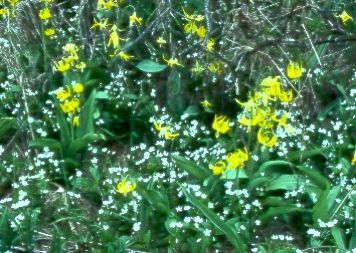
The bulbs of Glacier Lilies and Spring Beauties are a favourite food of grizzlies.
Grizzlies also dig for ground squirrels, especially in the fall. These diggings can be a metre deep. Scars can last many years in a meadow.
Bears move a lot. They are inquisitive by nature and capable of travelling large distances. When considering the activities of bears, think in terms of large areas with use varying with the seasons.
Precautions in bear country
Bears perceive their environment through their senses of smell, sound, and sight. When travelling in bear habitat, consider whether a bear could perceive your presence soon enough to avoid an encounter. A surprised bear can be aggressive, especially if it is feeding. However, in the vast majority of instances, a bear that picks up on the approach of a person disappears quietly into the bush. Most people will never know how often they have passed a bear without realizing it.
The most useful and easiest tactic a person can employ is to simply make noise. The human voice is a distinct a foreign sound. It does not matter what is said, just say it loudly! Bells are frequently used for this purpose, but their high pitch carries poorly and it can be tiresome to listen to all day. It is more effective to use your voice. Hiking in groups works well in bear country because people talk more in a group.
Consider the environment in which you are travelling. Surroundings such as dense, wet vegetation absorb sound. Rushing streams or wind also cover human sound and scent. Make louder and more frequent sounds in these situations. Streams can cause air to flow down valley. Hikers walking up a trail along a rushing stream need to pay extra attention to making their presence known.
Always look around. When walking on rough ground, hikers spend most of their time looking down. Make an effort to look about you, especially if you are first in line. Binoculars help in scoping out large open areas such as meadows before you enter them.
Avoid wearing perfumes or carrying especially smelly foods. Bears are curious because a new smell may mean a new food source.
When camping in bear habitat, consider the following:
- Choose a campsite that is off a natural travel corridor. Bears will travel on the path of least resistance.
- Plan to cook well away from your tent so if a bear does come by later to check out the inevitable cooking spills, you won’t be there. Choose to bring along simple-to-prepare foods that have little scent, i.e. oatmeal instead of bacon for breakfast.
- Never bring food into your tent for a late night snack. Should food spill on your tent, wash it.
- Carry 15 metres of small diameter rope for hanging food. Remember black bears climb trees well, so hang it off a branch out of reach. Where there are only very small trees such as subalpine areas, stash your food away from camp.
- Avoid campsites where litter is present. This could be the leftovers from a bear that has learned to associate people with food.
- Should you encounter a bear, stay calm. Most likely nothing will happen. Do not approach the bear. Speak in a calm voice to let the bear figure out what you are. Back away slowly. Don’t make eye contact.
If you are charged; climb a tree if you have time, other wise drop to the ground with your knees tucked into your chest and clasp your hands behind your neck. This shows the bear you are not aggressive. Most charges are a bluff. If the attack continues from a black bear it may be testing if you are possible prey; fight back. Remain in the tucked position when attacked by a grizzly.
Conservation
People travelling in bear country should not take bear safety lightly – but the likelihood of a bear attack is low. You are more likely to be struck by lightening!
Many thousands of bears killed each year in North America. While bears are protected in parks, few of these areas are large enough to encompass a bear’s home range. Grizzly bear populations are particularly vulnerable and are now absent from much of their historic range. Whether or not bears exist in the future is up to us. How we behave in regard to bears will determine their fate.
Bears reproduce slowly. Their numbers are heavily affected by hunting, poaching, and nuisance kills. While bears generally avoid settled areas, they can be attracted to communities by garbage and food left outside. Once bears learn to associate people with food they loose their normal aversion to people and become a potential public safety concern. As a result, Conservation Officers in British Columbia kill about 800 black bears and 50 grizzly bears each year.
If you live in a community near bear habitat, make sure you are not attracting bears to your home, thus placing bears, your family, and your neighbours at risk.
- Keep garbage in a secured building until pick-up day.
- Never leave fish or meat remains outdoors.
- Pick fruit as it ripens and clean up windfalls promptly.
- Clean barbecue grills or store them inside.
- Consider electric fences or simply eliminating bee hives, chicken coops, or compost piles if they are a continuing attractant.
For more information about bear safety within your community, visit the website of the Revelstoke Bear Aware Society.
Personal protection
Guns are very effective at killing bears, if you know how to use one. However, hunters are injured more often by bears than non-armed persons. This could be attributed to a few factors. Hunters walk as quietly as possible and are off well-used trails where bears expect people. Armed persons take more chances in bear habitat. Hunters injure bears and are then attacked. Hunters have been attacked near carcasses and gut piles that a bear subsequently claimed as its own.
Use of guns is not permitted in national parks.
Pepper spray is a non-lethal weapon that has successfully repelled bears. However, it must be used at close range. The spray would be useful in a camp situation where a bear showed increasing boldness over time. Removing the attractant is a better strategy.
Your best protection is awareness of bear activity and practicing avoidance techniques.

